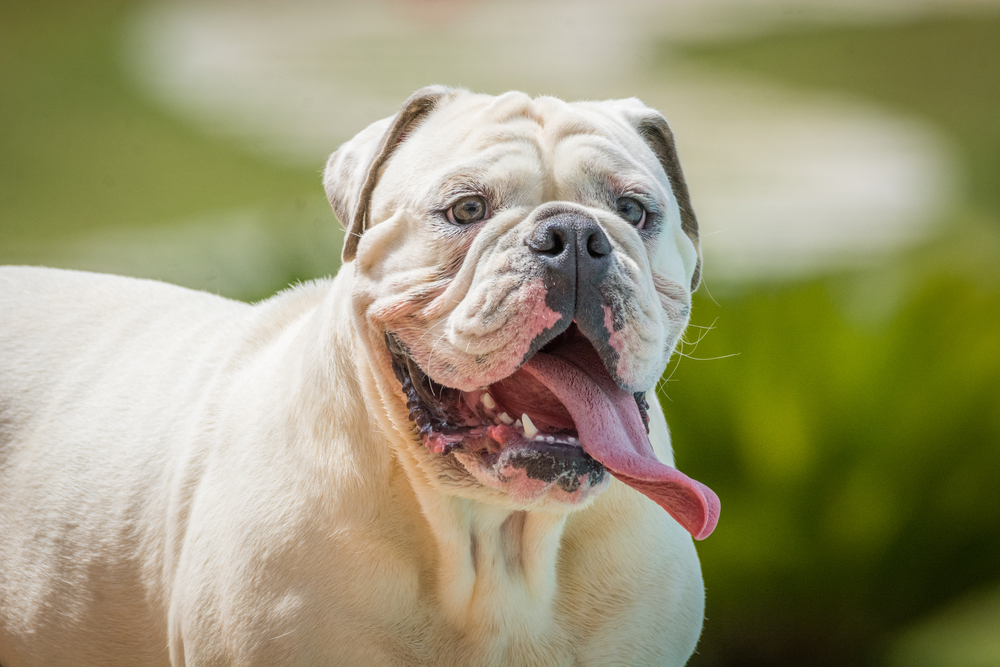In this article
View 8 More +If you couldn’t tell by the name, the Olde English Bulldogge is the original bloodline to the modern English Bulldog we know today. The breed almost went extinct, but thanks to breeding efforts, the Olde English Bulldogge still exists today. Let’s check out some interesting facts about this breed and learn more about where they come from.
Breed Overview
Height:
16 to 20 inches
Weight:
50 to 80 pounds
Lifespan:
10 to 13 years
Colors:
Brindle, white, fawn, red, black; solid colors can be with or without white
Suitable for:
Active families or singles
Temperament:
Confident, friendly, alert, expressive, docile
Olde English Bulldogges are short, robust dogs with short lifespans and a long list of health problems. But once upon a time, that wasn’t the case. They were once an athletic breed created for the English sport of bull baiting. The sport was eventually outlawed, causing the breed to almost vanish entirely.
Selective breeding revived the breed, but it was never the same again. Selective breeding caused severe health and lifespan issues we see in the modern English Bulldog. In the early 1960s, David Leavitt brought back the original bloodline: the Olde English Bulldogge—one that is agile, strong, proportioned, and with minimal health issues. Leavitt has since formed a registry ensuring the purity of the Olde English Bulldogge to anyone interested in raising the breed.
Olde English Bulldogge Characteristics

Olde English Bulldogge Breed Puppies

You will need to find a breeder if you want to raise an Olde English Bulldogge puppy, as this is not a breed you will find in shelters. The Leavitt Bulldog Association has a small list of breeders who can guarantee a 100% genetically pure Olde English Bulldogge puppy. Breeders through the Leavitt Bulldog Association put their puppies through extensive medical screening to ensure the breed is a top-notch, beautifully healthy breed.
As a rule of thumb, if your Olde English Bulldogge does not come with registration papers, it’s not worth the buy. Otherwise, you can’t guarantee the puppy has any relation to the original bloodline. Even if they do, they’re most likely not purebred.

Temperament & Intelligence of the Olde English Bulldogge
The Olde English Bulldogge is a wonderfully affectionate and submissive breed that loves their family. They love to play, are high-spirited, and never shy away from snuggles or work. An overly shy Olde English Bulldogge is considered a breeding fault but is likely from poor socialization in puppyhood.

Are These Dogs Good for Families? 🏡
Olde English Bulldogges make excellent family pets. They love to socialize with children and are highly affectionate and playful with the whole family. Olde English Bulldogs are ready to run around and play and are just as willing to be couch potatoes if needed. They can adapt to any environment as long as they have their owners to keep them company.
Like any breed, children mishandling them or improper puppy socialization can affect how they interact with other people and animals. Thankfully, breeders take great care to ensure your puppy is well-socialized. However, you must continue socializing them once you bring them home.
Does This Breed Get Along With Other Pets?🐶 😽
Generally, Olde English Bulldogges get along with all pets, including small ones (although you need to be mindful of prey animals). These dogs tend to show occasional same-sex aggression with other dogs, but it’s nothing a little training can’t fix.

Things to Know When Owning an Olde English Bulldogge
Food & Diet Requirements 🦴
The Olde English Bulldogge will do very well on high-quality dog food rich in protein, fatty acids, and probiotics. This is a very active breed, so high-protein, high-calorie dog food could be the best choice to meet the energy requirements. If you’re ever concerned about what you should be feeding them, it’s always best to consult your vet, who will give you some recommendations for their specific breed.

Exercise 🐕
The Olde English Bulldogge can adapt to any lifestyle. They will happily go on a run with you and just as quickly hop up on the couch to snuggle. This breed is easy to please and is fine with active or lazy days any day.
Generally, these dogs are pretty active, so daily exercise is always recommended. A long walk, run, or a simple game of fetch will do the trick. Luckily Olde English Bulldogges withstand the heat and cold much better than the modern English Bulldog, so you don’t need to worry about overheating as much.
Training 🎾
Because of their physical strength and energy, it’s vital to start training an Olde English Bulldogge as soon as you can. Olde English Bulldogges are willing to please and submit, similar to a Labrador Retriever, so you should have no problem training. They have no problem learning new skills and are very food-motivated, which is something to keep in mind if you’re new to being a pet parent.
Grooming ✂️
Some Olde English Bulldogges have more wrinkles than others and will need more time spent cleaning those wrinkles. Wrinkles require weekly cleanings in addition to ear cleanings and nail trims. Their medium-short coats require no special care, but it’s fine to wash them once a month or whenever they get dirty with a pet-safe shampoo.

Health and Conditions 🏥
Olde English Bulldogges are a typically healthy breed, assuming you’re purchasing your puppy from a reputable Leavitt breeder. Your Bulldogge should have no breathing, dental, hip, or joint issues.
Regardless, all dogs, regardless of breed, can still develop allergies, dental disease, obesity, tick and flea-borne illnesses, and more. Proper veterinary care, nutrition, and regular grooming sessions can help prevent these common ailments.
- Skin problems
- Hypothyroidism
- Heart disease
- Obesity

Male vs. Female
There are no significant differences between male and female Olde English Bulldogges except in size. The females tend to be smaller in stature compared to the males, but this isn’t that noticeable, as it largely depends on the parents and the individual dog.

3 Little-Known Facts About the Olde English Bulldogge
1. Bulldogs Were Once an Athletic Breed
Bulldogs were originally used for the English sport of bull baiting, a sport where dogs and bulls were pinned against each other. It was practiced from 1100 to 1835 until finally outlawed. The Olde English Bulldogge resembles exactly what these Bulldogs looked like back then: taller, more physically agile dogs capable of performing in such a sport.
2. The OEB Can Give Birth Naturally
Olde English Bulldogs can mate and give birth naturally because of their well-proportioned bodies, while the modern English Bulldogs are known for having birthing complications.
3. The OEB and Leavitt OEB Are Not the Same Thing
Since bringing back the breed, many people have used the term “Olde English Bulldogge” as a general name for dogs not even related to the bloodline. This caused inconsistencies with the appearance and health of the OEB—the actual percentage of OEB is quite small. David Leavitt formed a registry in 2006 and called the original Olde English Bulldogge the Leavitt Bulldog to ensure the purity of the breed.


Final Thoughts
The Olde English Bulldogge is proof that so many dog breeds have bounced back from the brink of extinction. Science and breed enthusiasts are always the ones who help make the breed’s comeback possible.
In reality, the Olde English Bulldogge isn’t a popular breed compared to the modern English Bulldog, but it’s a breed we should consider. When you look at how much the English Bulldog struggles and then look at the OEB, some can’t help but wonder why we ever let the English Bulldog get to where it is now.
Featured Image Credit: Thorsten Stark, Shutterstock


















